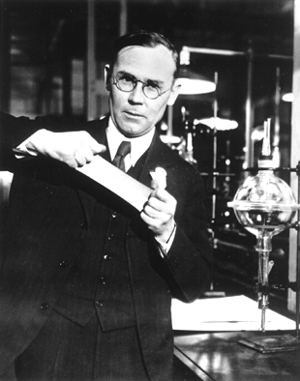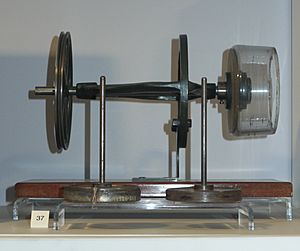Synthetic fiber facts for kids
Synthetic fibers are special threads made by people, not by nature. Think of them like man-made versions of natural fibers such as cotton or wool. Scientists worked hard to create these fibers, trying to make them as good as or even better than natural ones.
They are usually made by pushing liquid chemicals through tiny holes, like squeezing toothpaste, to form long, thin threads. The word 'polymer' comes from Greek words meaning 'many parts'. Imagine a long chain; each link in the chain is a 'monomer', and the whole chain is a 'polymer'.
Contents
The Start of Man-Made Fibers
Nylon was the first very successful man-made plastic fiber. A company called DuPont started researching it in 1927. The first type of nylon, called nylon 66, was created on February 28, 1935. It was made by a scientist named Wallace Carothers at DuPont's research center.
Another important step was taken by Hilaire de Chardonnet, a French engineer. He invented the first artificial silk, which he called "Chardonnet silk." In the late 1870s, Chardonnet was helping Louis Pasteur with a problem that was harming French silkworms. One day, Chardonnet accidentally spilled some chemicals in his darkroom. This led him to discover that a substance called nitrocellulose could be used instead of real silk.
Chardonnet realized how important this discovery was. He started to develop his new material and showed it at the Paris Exhibition in 1889. However, Chardonnet's material could catch fire very easily. Because of this, other safer materials later replaced it.
Popular Man-Made Products
The first successful way to make a fiber called "viscose" was developed in 1894. English chemist Charles Frederick Cross and his team created it. They named it "viscose" because the liquid they made was very thick, or "viscous." The first commercial viscose rayon was made by a UK company called Courtaulds in 1905. The name "rayon" was chosen in 1924. Rayon and cellulose acetate are artificial fibers, but they are not fully synthetic. This is because they are made from wood, which comes from nature.
Nylon was the first truly "fully synthetic" fiber. It was developed by Wallace Carothers at the DuPont company in the 1930s. Nylon quickly became popular in the United States. It was used to replace silk, especially when rationing started during World War II. Many people knew nylon for women's stockings. But it also had important uses for the military, like replacing silk in parachutes and making ropes.
The first polyester fiber was patented in Britain in 1928. British chemists John Rex Whinfield and James Tennant Dickson also produced it in 1941. They created and patented one of the first polyester fibers, which they named Terylene. This fiber was also known as Dacron. It was as strong or even stronger than nylon. Big companies like ICI and DuPont then made their own versions of polyester.
In 2014, the world produced 55.2 million tonnes of synthetic fibers.
What Synthetic Fibers Are Like
About half of all fibers used today are synthetic. They are used in almost every area of clothing and textile technology. Many types of fibers made from man-made plastics have been tested. However, four main types are most popular: nylon, polyester, acrylic, and polyolefin.
These four types make up about 98 percent of all synthetic fiber production. Polyester alone accounts for around 60 percent of this.
Synthetic fibers can cause microplastic pollution. Tiny pieces can break off in laundry machines.
Common Synthetic Fibers You Might Know
Here are some common synthetic fibers:
- Nylon (first made in 1931)
- Modacrylic (first made in 1949)
- Olefin (first made in 1949)
- Acrylic (first made in 1950)
- Polyester (first made in 1953)
Here are some special synthetic fibers:
- Rayon (1894) – also called artificial silk
- Vinyon (1939)
- Saran (1941)
- Spandex (1959)
- Vinalon (1939)
- Aramids (1961) – like Nomex, Kevlar, and Twaron
- Modal (1960s)
- Dyneema/Spectra (1979)
- PBI (1983)
- Sulfar (1983)
- Lyocell (1992) – artificial, not fully synthetic
- PLA (2002)
- M-5 (PIPD fiber)
- Orlon
- Zylon (PBO fiber)
- Vectran (TLCP fiber)
- Derclon – used in rugs
Other man-made materials used in fibers include:
- Acrylonitrile rubber (1930)
Modern fibers made from older artificial materials include:
- Glass fiber (1938) is used for:
- insulation in homes and cars (glass wool)
- making strong composite materials (glass-reinforced plastic)
- special papers in battery parts
- Metallic fiber (1946) is used for:
- adding shiny looks to clothing for fashion
- stopping static electricity from building up
- carrying electricity to send information
- moving heat
See also
 In Spanish: Fibra sintética para niños
In Spanish: Fibra sintética para niños
- Artificial turf
- Elasterell
- Rope
- Delustrant



